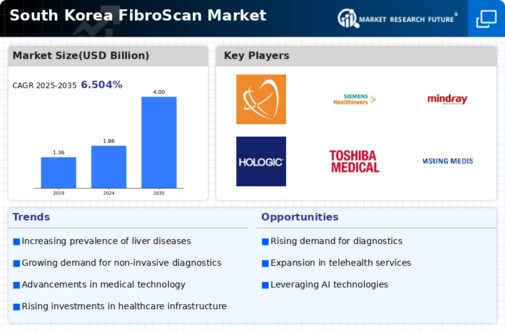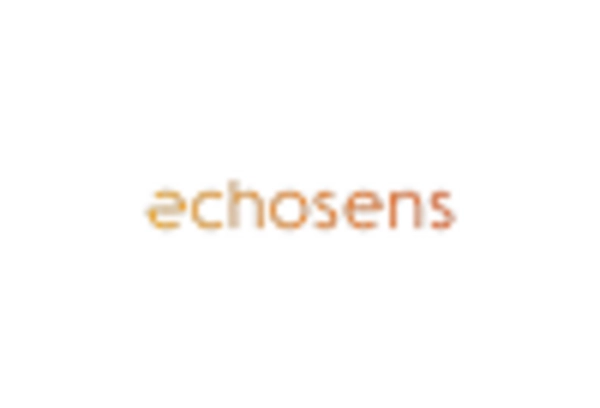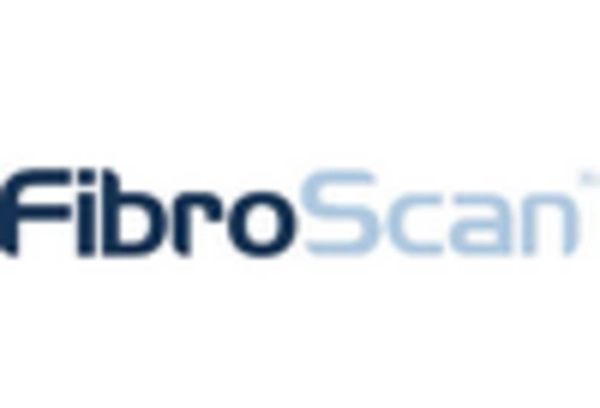Growing Geriatric Population
The demographic shift towards an aging population in South Korea is a notable driver for the fibroscan market. As the elderly population continues to expand, the prevalence of age-related health issues, including liver diseases, is expected to rise. Older adults are more susceptible to conditions such as cirrhosis and liver cancer, necessitating regular monitoring and assessment of liver health. Fibroscan technology, with its non-invasive approach, is particularly appealing for this demographic, as it minimizes discomfort and risk associated with traditional biopsy methods. Therefore, the increasing geriatric population is likely to contribute to the heightened demand for fibroscan devices, thereby propelling the growth of the fibroscan market.
Advancements in Medical Technology
Technological innovations in medical devices are playing a pivotal role in shaping the fibroscan market. Recent advancements have led to the development of more sophisticated and user-friendly fibroscan devices, enhancing their accuracy and efficiency. These improvements not only facilitate better diagnosis but also increase the accessibility of fibroscan technology in various healthcare settings, including outpatient clinics and hospitals. The integration of artificial intelligence and machine learning into fibroscan devices is expected to further refine diagnostic capabilities. As a result, the enhanced performance and reliability of these devices are likely to attract more healthcare providers, thereby stimulating growth in the fibroscan market.
Government Initiatives for Liver Health
The South Korean government has been actively promoting initiatives aimed at improving liver health, which serves as a significant driver for the fibroscan market. Various public health campaigns and educational programs are being implemented to raise awareness about liver diseases and the importance of early detection. Additionally, the government is investing in healthcare infrastructure, which includes the procurement of advanced diagnostic tools like fibroscan devices. These initiatives not only enhance public access to liver health screenings but also encourage healthcare facilities to adopt innovative technologies. Consequently, the supportive regulatory environment is likely to foster growth in the fibroscan market.
Increasing Prevalence of Liver Diseases
The rising incidence of liver diseases in South Korea is a crucial driver for the fibroscan market. Conditions such as non-alcoholic fatty liver disease (NAFLD) and hepatitis are becoming more common, affecting a significant portion of the population. According to recent health statistics, approximately 25% of adults in South Korea are estimated to have some form of liver disease. This alarming trend necessitates the need for effective diagnostic tools, such as fibroscan devices, which provide non-invasive assessments of liver stiffness and fat content. As healthcare providers seek to improve patient outcomes, the demand for fibroscan technology is likely to increase, thereby propelling the growth of the fibroscan market in the region.
Rising Awareness of Preventive Healthcare
There is a growing awareness among the South Korean population regarding the importance of preventive healthcare, which significantly impacts the fibroscan market. As individuals become more health-conscious, they are increasingly seeking early detection methods for potential health issues, particularly liver-related conditions. This shift in mindset is reflected in the increasing number of health check-ups and screenings being conducted across the country. The fibroscan technology, known for its non-invasive nature and quick results, aligns well with this trend. Consequently, healthcare providers are likely to incorporate fibroscan devices into routine examinations, further driving the demand for these diagnostic tools in the fibroscan market.

















Leave a Comment